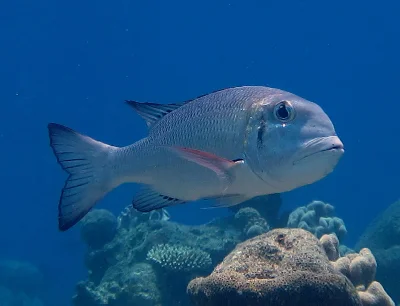Picnic Seabream
Acanthopagrus berda
Acanthopagrus berda, commonly known as the goldsilk seabream, is a species of ray-finned fish within the Sparidae family, encompassing sea breams and porgies. This species predominantly inhabits the 🌊 Indian Ocean.
The formal classification of Acanthopagrus berda as Sparus berda was established in 1775 by Danish zoologist Johan Christian Fabricius, based on observations recorded by Peter Forsskål during an expedition to Arabia. The type locality is identified as Al Luhayyah, 🇾🇪 Yemen. There is some debate regarding the taxonomic placement of Acanthopagrus, with certain experts placing it in the subfamily Sparinae. However, the 5th edition of Fishes of the World does not recognize subfamilies within the Sparidae.
The species name "berda" is derived from its local designation along the 🌊 Red Sea coast of 🇾🇪 Yemen. Acanthopagrus berda is characterized by a relatively deep and compressed body, with the body depth fitting into its standard length approximately 2.4 to 2.6 times. Its dorsal fin comprises 11 or 12 spines, while the anal fin features 3 spines and 8 or 9 soft rays. The species possesses robust, molar-like teeth arranged in curved rows on the lower jaw. The external coloration is dark olive brown, transitioning to a nearly black hue when the fish is stressed or excited, with a paler, metallic tint on the lower body. The maximum documented total length is 90 cm, with an average length of approximately 35 cm. The maximum published weight is 3.2 kg, and the species can live up to 14 years.
Acanthopagrus berda is distributed along the eastern African coastline from 🇪🇬 Egypt to the Eastern Cape of 🇿🇦 South Africa and extends eastward to Peninsular 🇲🇾 Malaysia, 🇸🇬 Singapore, and Sumatra (🇮🇩 Indonesia). While there are unverified reports of this species inhabiting freshwater environments in southern Africa, it has been confirmed in freshwater in 🇲🇬 Madagascar. Observations from the 🌊 Persian Gulf are likely misidentifications of A. randalli. The goldsilk seabream relies on estuarine environments and is typically located in sand and mud substrates at depths reaching 50 meters. Juvenile and subadult individuals are typically found in sheltered bays and estuaries.
As a predatory species, Acanthopagrus berda feeds primarily on crustaceans, notably crabs and barnacles, as well as bivalves, including mussels of the Modiolus genus and oysters. Its diet also includes fish, squid, and plant material. This species is a protandrous hermaphrodite, with functional males predominating in smaller size classes. Adult individuals possess ovotestes and may function as either male or female during spawning, which occurs from August to December off the coast of Kerala.
Acanthopagrus berda is favored by recreational anglers and does not appear to be subject to extensive fishing pressure. It is targeted by artisanal fisheries in 🇮🇳 India and is under investigation for aquaculture development potential in the region.
Comments
Please, sign in to leave comment
No Comments yet
Last Update: May 28, 2025

